10 Most Exotic and Coolest Freshwater Aquarium Fish (With Pictures)
Most people mistakenly believe that exotic fish that have bright colors are only found in the depths of seas and oceans.
The truth is that there are lots of interesting and easy to care for cool fish that live in freshwater and can make a great addition to your freshwater aquarium.
Maintaining a freshwater aquarium is probably a little bit easier than taking care of a saltwater one.
In this guide, you’ll find everything you need to know about the most exotic and coolest freshwater aquarium fish and how to take care of them.
Table of Contents
10 Most Exotic and Coolest Freshwater Aquarium Fish
Fish are sensitive creatures so you need to make sure that you’re creating the perfect conditions that allow them to live healthily.
When the aquarium is kept in a good state, the fish will show their brightest colors and create an unmatched rainbow of cool hues that you’ll never get tired of watching.
Here are 10 of the most interesting freshwater fish breeds.
Swordtail
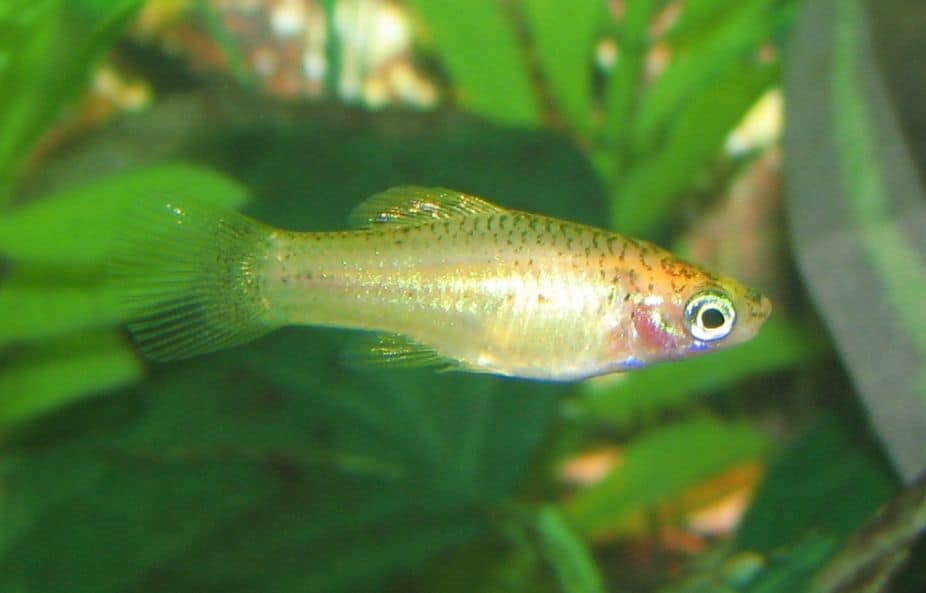
Swordtail Fry (Xiphophorus hellerii) by Ltshears (CC BY-SA 3.0)
Swordtails are also known as Black, Gold Tux, Black Velvet, and Red Velvet Swordtails. They are found in the streams, rivers, and canals in Mexico, Honduras, and Guatemala.
They have elongated bodies that are usually olive green with orange, red, yellow, or brown stripes.
There are soft rays on the dorsal and anal fins, and the males usually have a sword-like structure that protrudes from the caudal fin. The sword is usually yellow.
In their natural habitat, Swordtails are omnivores feeding on plant matter, insects, larvae, and crustaceans. The males are usually 14 cm long while the females are slightly bigger measuring 16 cm long.
Easy to care and peacefull in community tank
Swordtails are easy to care for and can live up to 5 years with proper care. They eat flakes, fresh or frozen food when you keep them in your freshwater tank. You need to feed them several times a day.
These fish live peacefully in a large community tank where there’s plenty of swimming space. They can also be kept in a small tank as long as it’s not crowded. They prefer slightly alkaline water with regular water changes every 3 to 4 weeks.
Females produce up to 200 eggs so you need to make sure that there’s dense floating that protects the fry from more aggressive fish. The adult fish should be well fed; otherwise, they might start feeding on the fry.
You should keep a lid on top of the tank to prevent the fish from jumping. Swordtails live peacefully with other less aggressive fish like Mollies, Angelfish, and Black Skirt Characins.
- Care level: Beginner.
- Temperament: Peaceful.
- Life expectancy: 5 years.
- Water pH: 7.0 to 7.5 pH.
- Tank size: +20 gallons.
- Perfect mates: Mollies, Angelfish, and Black Skirt Characins.
Dwarf Gourami

The Dwarf Gourami is native to Bangladesh and India but is currently one of the most popular fish breeds in freshwater community tanks.
In their natural habitat, these fish prefer slow-moving waters of rivers, canals, ponds, ditches, swamps, and rice fields.
Today, they’re very popular among beginners and experienced aquarists because they’re quite easy to care for. They also make a special bright and colorful addition to any community tank as peaceful members that get along with other species.
The males grow up to 8 cm while the females are usually smaller, growing up to 6 cm. The fish have bright orange or red compressed bodies with large fins.
The males usually have blue stripes while the females have silver stripes on their bodies.
The Dwarf Gourami fish are omnivores that feed on plants, algae, as well as small invertebrates. In a water tank, they will eat flakes, fresh food, frozen bloodworms, and brine shrimp. They should be fed twice a day.
Quite sensitive labyrinth fish
This is a labyrinth fish that breathes directly from the air, so individuals will be swimming near the top of the tank.
They prefer to have plenty of plants where they can hide and require weekly water changes because they’re quite sensitive. They’re suitable for a smaller community tank.
Installing a potent filtration system is a must because these fish can’t tolerate toxins and chemicals. They also prefer highly oxygenated water, so you need to keep some air stones.
The male builds a nest using plant bits where the female lays 300 to 800 eggs. The female should be removed from the tank while the male keeps the eggs in his mouth and moves them to the nest.
After the eggs hatch, the fry stays in the nest for a few more days. The male should be removed from the tank and the fry will start swimming and feeding on liquid fry food or baby brine shrimps.
The Dwarf Gourami fish get along with other peaceful freshwater species like Harlequin Rasboras, Corydoras, and Rainbow Fish. They don’t prefer to live with fin nippers like Bettas.
- Care level: Intermediate.
- Temperament: Peaceful.
- Life expectancy: 7 years.
- Water pH: 6.0 to 8.0 pH.
- Tank size: +5 gallons.
- Perfect mates: Harlequin Rasboras, Corydoras, and Rainbow Fish.
Discus
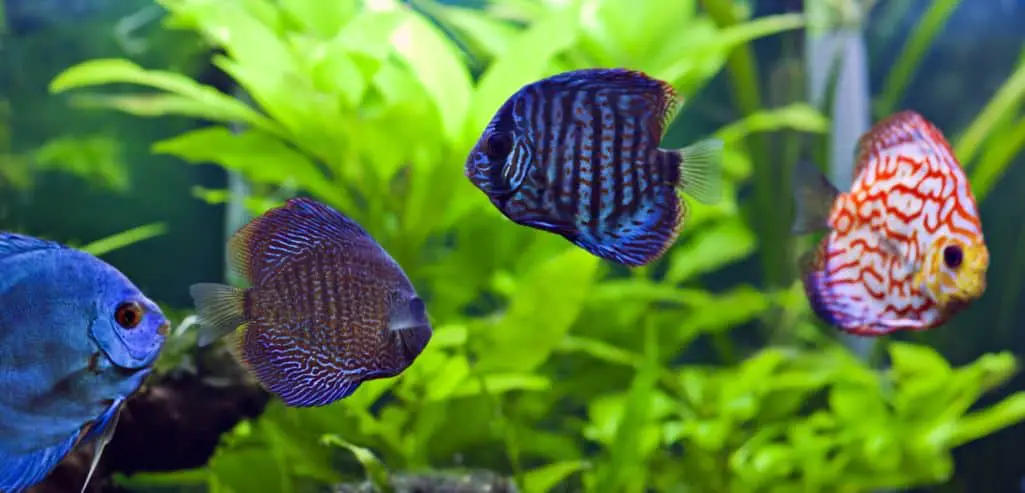
These fish are known for their disc-shaped bodies and large dorsal fins. Discus fish are tropical fish native to the Amazon River but prefer calmer waters near the river bank.
Several colorful patterns grow in captivity including blue, orange, red, brown, and green. The body usually has 9 dark stripes and might have spots or blotches.
These fish feed on aquatic insects and worms in their natural habitat. But they will eat algae flakes, tropical fish flakes, and shrimp pellets when they live in a tank.
They need plenty of space with lots of aquatic plants like Water Onions that provide shade because they prefer to swim in the shadows, so it’s best to keep them in a large tank of 75 gallons or more.
Schooling Fish
Unless you’re an experienced aquarist, you shouldn’t keep Discus fish with other members of their species as they might not get along with all breeds in a large community tank, especially when there are lots of bottom dwellers that obstruct their access to food.
These are schooling fish, so you should have at least 6 Discus fish in your tank; otherwise, the fish will be stressed out.
Discus fish are one of the most exotic and coolest freshwater aquarium fish. They can live for more than 10 years and can grow up to 22 cm in length. They need to eat 2 or 3 times a day to stay in perfect health.
Water should be filtered and they prefer if it’s slightly acidic. They can get along with Congo Tetras, Neon Tetras, and Cardinal Tetras.
- Care level: Intermediate.
- Temperament: Peaceful.
- Life expectancy: 10 years or more.
- Water pH: 6.0 to 7.0 pH.
- Tank size: +75 gallons.
- Perfect mates: Congo Tetras, Neon Tetras, and Cardinal Tetras.
Elephantnose
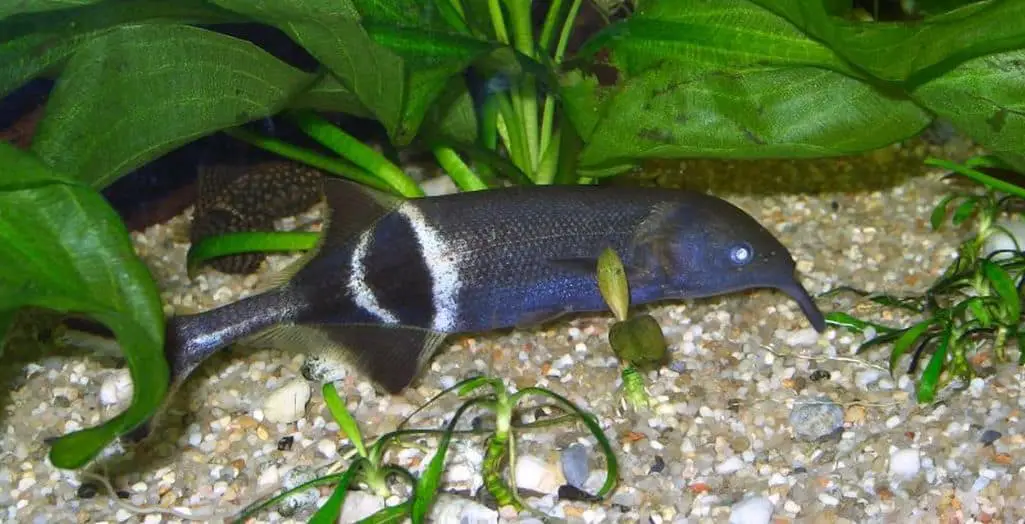
These fish look a bit unusual due to the shape of their mouths that looks a lot like the elephant’s nose or trunk. They’re native to the African continent, preferring muddy waters of the Niger River which has a thick plant growth.
The Elephantnose fish are bottom dwellers that always look for food using their long protruding mouth. They prefer to feed on spineless creatures, worms, and aquatic insects.
They also produce a weak electric field that allows them to move and communicate with other members of their family.
In their natural habitat, these fish can grow to about 35 cm, but they won’t usually grow more than 25 cm when kept in a tank. They have elongated dark brown or black bodies with no abdominal fins.
The protruding mouth has a lot of nerve endings that produce the weak electric current that allows the fish to navigate peacefully in muddy water.
When these fish are kept with 7 or more members of their family, they’re less likely to show signs of aggression. They should be kept away from strong light so they feel safe and comfortable.
Not a beginner fish
These fish aren’t suitable for beginner aquarists because they’re very sensitive and require special care. They need special shelters like plants and smooth stones. The bottom should be covered with sand so that the fish don’t damage their sensitive mouths.
The Elephantnose fish prefers to hide all day and becomes active at night. They can eat frozen food when kept in a tank, but they will prefer to feed on live food like bloodworms.
These fish prefer to live with other peaceful tank mates that won’t compete for food.
However, you should make sure not to keep them with very small fish as the Elephantnose fish might be tempted to eat them. They can be kept with Discus, Angelfish, and Tetras.
- Care level: Experienced
- Temperament: Semi-aggressive.
- Life expectancy: 7 to 10 years.
- Water pH: 6.5 to 7.0 pH.
- Tank size: +50 gallons.
- Perfect mates: Discus, Angelfish, and Tetras.
Endler’s Livebearer

Native to Northern Venezuela, the Endler’s Livebearer is a hardy fish that prefers warm hardy waters. It’s a beautiful tropical freshwater fish with eye-catching colors along its elongated body.
There’s a bright neon orange line along the body that goes all the way to the caudal fin with a black mark on the side.
The Endler’s Livebearer reaches a maximum length of 4 cm; with females having slightly larger bodies. The males usually display bright patterns of black, orange, green, and blue, while the females are usually pale green.
These are omnivores that eat worms, algae, and invertebrates in their natural habitat. Food should be offered 2 or 3 times per day and they can eat all types of frozen and live foods as long as it’s offered in small amounts.
Java moss lover
The Endler’s Livebearer fish prefer to have enough swimming space with excellent lighting and heavy vegetation of Java moss, Java fern or duckweed.
However, they can be a suitable choice for someone who wants to keep a smaller 5 or 10-gallon tank. These fish can jump so fitting a lid is recommended.
They prefer to swim in the upper regions of the tank along with other peaceful community fish like smaller Rainbow Fish, Dwarf Gourami, Tetras, and Dwarf Corydoras.
- Care level: Beginner.
- Temperament: Peaceful.
- Life expectancy: 5 years.
- Water pH: 7.0 to 7.5 pH.
- Tank size: +5 gallons.
- Perfect mates: smaller Rainbow Fish, Dwarf Gourami, Tetras, and Dwarf Corydoras.
Fantail Guppy

Also known as the Fancy Guppy, Rainbow Fish, Fancy Millions Fish, and Ornamental Guppy, is a popular freshwater community tank fish that is native to Trinidad, Venezuela, and Barbados.
It gained its popularity as it was introduced to different parts of the world to fight malaria as it mainly feeds on mosquito larvae in its natural habitat.
The Fantail Guppy fish is characterized by having a black or silver body with a large dorsal fin that spreads out in the shape of a fan.
The fish usually have striking patches and stripes of bright colors like red, lime green, yellow, blue, and orange, adding a colorful display to your tank. The male fish is usually 3 cm long and the females are twice as big.
Quite easy to care for
This fish is quite easy to care for as it can tolerate some saltiness in the water. The Fantail Guppy feeds on algae, freeze-dried worms, flakes, and brine shrimp. They also don’t mind eating small pieces of cucumbers and lettuce. Food should be offered 3 or 4 times a day.
These fish are suitable for beginners as well as experienced aquarists and prefer hard water. Changing 25% to 50% of the water twice a month is recommended to keep the fish healthy.
The Fantail Guppy fish shouldn’t be kept with other aggressive or fin nipping fish like the Tiger Barbs. Their perfect mates include the Livebearers, Rasboras, and small Tetras.
- Care level: Intermediate.
- Temperament: Peaceful.
- Life expectancy: 5 years.
- Water pH: 7.0 to 8.0 pH.
- Tank size: +10 gallons.
- Perfect mates: Livebearers, Rasboras, and small Tetras.
Electric Blue Hap

Electric blue hap by burnse1 (CC BY-SA 4.0)
Another one of the most exotic and coolest freshwater aquarium fish. The Electric Blue Hap is one of the most popular African Cichlids due to its striking electric blue color.
Native to Lake Malawi, this shy fish prefers to have some rocks in the tank as it likes to hide most of the day.
The females of this breed have stocky and elongated silver bodies but the males are the ones that get all the attention with their unusual color.
Some males will have some dark marks on their bodies and all have some red or orange on the anal fin.
These are schooling fish that should be kept in groups of 3 to 6 members, with only one male in the group. It’s also a good choice if you want to have a pair in a tank.
The fish can grow to reach a maximum length of 15 cm and they prefer to have plenty of space for swimming.
They shouldn’t be kept with other species that have a similar coloring like the Electric Blue Johanni as the males will compete and try to kill each other.
Not suitable for community tank
These fish usually feed on smaller fish so they’re not suitable candidates for a community tank with lots of other smaller species.
You should provide them with a balanced diet of Cichlid pellets, flakes, and frozen food, in addition to some vegetation. They don’t have to be fed every day and food should be offered in small amounts as they tend to overeat.
Weekly water changes of 10% or 20% are recommended to keep the fish healthy as they’re very sensitive to contaminated water. Adding salt as a buffering agent is recommended to increase the hardiness of the water.
They can be kept with Haplochromis and Mbuna. However, they should be kept away from female and male Peacock Cichlids because males of the Electric Blue Hap will kill the males and try to mate with the females.
- Care level: Intermediate.
- Temperament: Semi-aggressive.
- Life expectancy: 7 to 10 years.
- Water pH: 7.5 to 8.5 pH.
- Tank size: +55 gallons.
- Perfect mates: Haplochromis and Mbuna.
Zebra Pleco
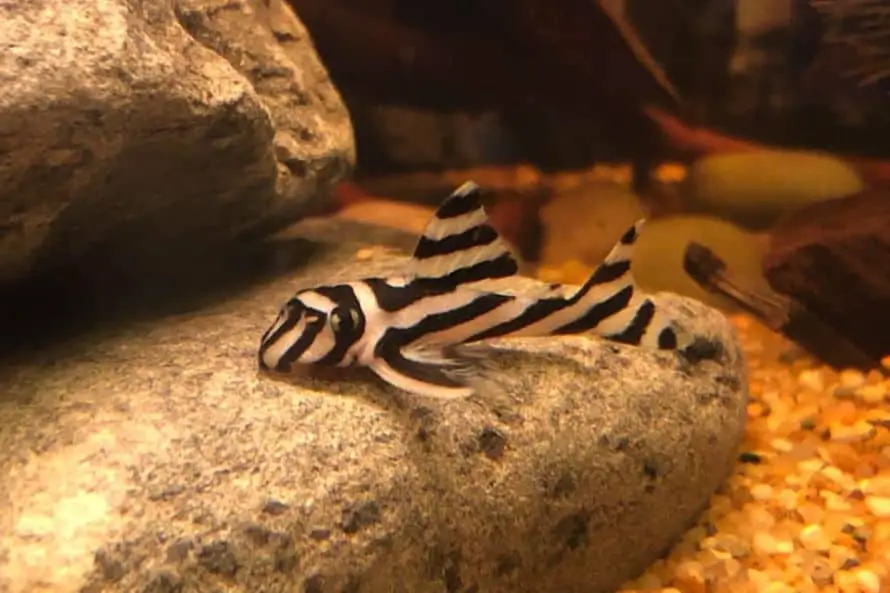
Zebra Pleco by Peaceinpianos (CC BY-SA 4.0)
This interesting catfish is native to the Xingu River in Brazil and is a bit rare to find but you can still get some for your freshwater community tank.
The Zebra Pleco fish have a white body with black lateral stripes, resembling the pattern of the zebra. They also have 4 whiskers.
A perfect tank should have plenty of vegetation, rocks, as well as driftwood and sand. These shy fish prefer to live in a tank where there are plenty of places to hide as they are rather shy and will feel safer this way.
The Zebra Pleco fish are nocturnal bottom dwellers that don’t prefer to compete for food.
Can live up to 15 years
They can grow to reach a maximum length of 10 cm and will live up to 15 years with proper care. Making the fish feel safe will encourage them to come out more often.
They are omnivores and in their natural habitat will eat plants as well as worms and larvae. In a tank, they can eat frozen as well as live food.
You can feed them bloodworms, brine shrimp, crushed peas with the skin removed and smaller pieces of zucchini. They won’t eat algae and food should be offered 2 or 3 times a day.
Regular water changes are recommended to keep the water highly oxygenated. They should be kept with other peaceful tank mates because they’ll start to show aggressive behavior if only kept with members of their breed.
They can be kept with Fantail Guppies and Hatchetfish that like to swim in the top part of the tank.
- Care level: Intermediate.
- Temperament: Peaceful.
- Life expectancy: 10 to 15 years.
- Water pH: 6.5 to 7.0 pH.
- Tank size: +20 gallons.
- Perfect mates: Fantail Guppies and Hatchetfish.
Arowana
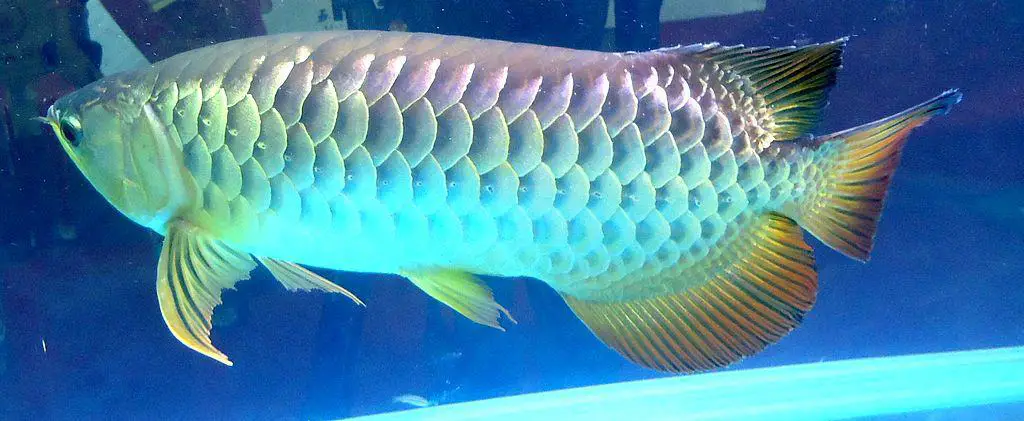
Arowanas are native to the Amazon River and characterized by being powerful swimmers who can easily survive in a challenging environment.
They have elongated bodies with a mouth that faces upward because they breathe air at the surface of the water.
In spite of their small bodies, Arowanas have very sharp teeth and powerful jaws. They have elongated bodies that come in several colors of blue, silver, and red.
The Silver Arowana tends to jump out of the tank, especially when startled.
In their natural habitat, these fish can reach 1 meter long, but they will usually be 70 cm long in a freshwater tank. These are experienced hunters who can become sluggish when the level of oxygen is low.
In the river, these fish feed on insects, crustaceans, smaller fish and even smaller birds, rabbits, frogs or snakes that can be found in the water.
They need to be provided with live food like shrimp, crabs, and bugs when kept in a tank. They can also feed on fish pellets but they don’t prefer to.
Might tempt to jump out
They need to live in a large tank with plenty of swimming space. Silver Arowanas should be kept in a long rather than deep tank with some lid protection because they’re likely to leap out of the water.
Heavy vegetation should be avoided as the fish need to swim freely; otherwise, they might tempt to jump out for freedom.
Because these are big fish that eat lots of food, they will produce lots of water material. A strong filtration system is recommended to keep the tank healthy and clean.
You should keep the tank in a low-traffic area because the fish can be easily spooked if you walk past them or turn the light on all of a sudden.
These are aggressive predators that are likely to attack others. Smaller fish should be kept in groups of 6 or more so they can protect each other from being attacked by adult Arowanas.
Bigger fish get along with Green Terrors, Parrot Cichlids, and Angelfish as they are too big for the Arowanas to eat.
- Care level: Experienced.
- Temperament: Semi-aggressive.
- Life expectancy: 10 to 15 years.
- Water pH: 6.5 to 7.5 pH.
- Tank size: +250 gallons.
- Perfect mates: Green Terrors, Parrot Cichlids, and Angelfish.
Flowerhorn Cichlid
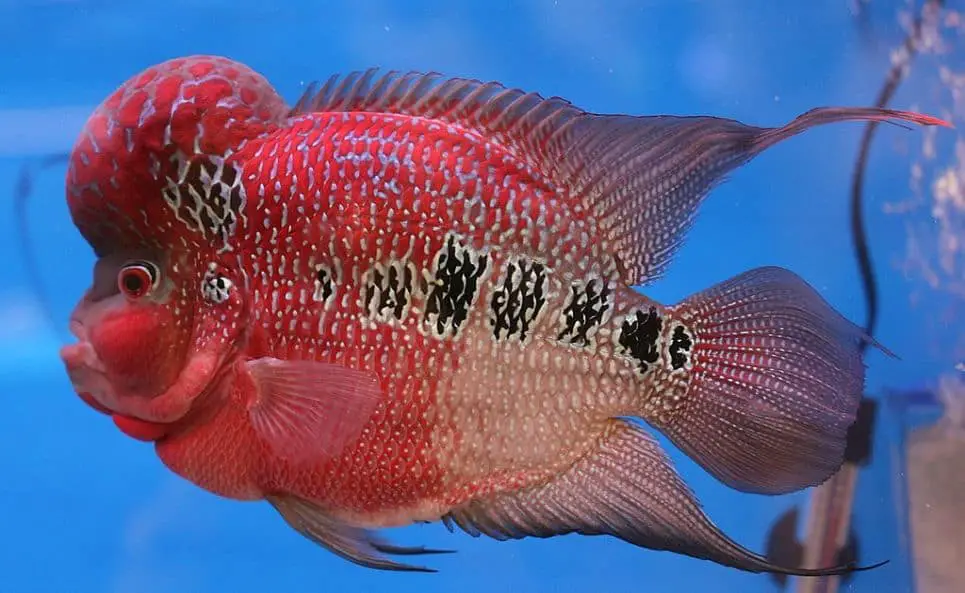
Clearly one of the most exotic and coolest freshwater aquarium fish, the Flowerhorn Cichlids are interesting man-made hybrids that can’t be found in the wild.
This breed was originally bred in Malaysia and spread to freshwater tanks across the world due to the distinctive horn protrusion.
This fish keeps on changing its pattern until it reaches maturity, usually having a silver body with red stripes. Some fish might develop into more interesting colors as they grow. These fish grow to be 40 cm long and are very hardy.
The Flowerhorn Cichlid has a thick oval body with a nuchal hump on the head. Some fish have a black marking on the body while others lack this feature.
This fish has a separate set of teeth located near the throat in addition to the regular teeth.
Like to dig
Keeping one fish in your medium-sized community tank is recommended, although you can keep more if you have a larger one.
The Flowerhorm Cichlids like to dig in the substrate and will feed on any plants found in the tank. If you choose to place rocks at the bottom of the tank, you should make sure that they’re perfectly secured so that this active fish doesn’t mess up with the display in your freshwater tank.
The Flowerhorn Cichlid fish is aggressive and territorial, so it’s best kept alone as a show fish. The perfect diet can be a combination of frozen and live foods in addition to pellets and flakes.
These fish are messy eaters, so regular cleaning of the tank is recommended. You should be careful during feeding times or while cleaning the tank as they can bite you.
Since the Flowerhorn Cichlids are quite aggressive, they’re best kept with larger fish that they can’t attack. These include Jaguar Cichlids, Pirapitinga, Giant Gourami, and Bushynose Catfish.
- Care level: Experienced.
- Temperament: Aggressive.
- Life expectancy: 8 to 10 years.
- Water pH: 6.5 to 7.5 pH.
- Tank size: +250 gallons.
- Perfect mates: Jaguar Cichlids, Pirapitinga, Giant Gourami, and Bushynose Catfish.
Conclusion
Maintaining a balanced ecosystem is a must to keep your freshwater fish in perfect health. This includes encouraging the growth of good bacteria and using a testing kit to keep the level of ammonia under control.
Before introducing a new fish, you should keep it isolated for a couple of weeks to make sure that it won’t transmit any disease to the fish you already have. Keep an eye on the feeding schedule to protect your fish from overeating.
Whether you’re a beginner or experienced aquarists, there are lots of exotic and cool freshwater aquarium fish that you can add to your tank.
Spend your time to study different species and make sure that you’ve created the perfect home for the fish you prefer.




